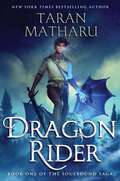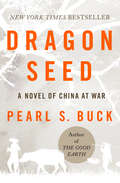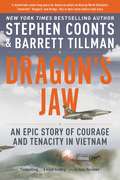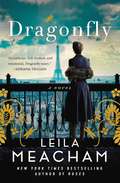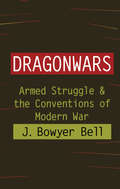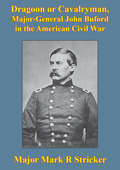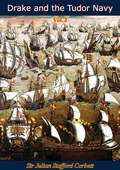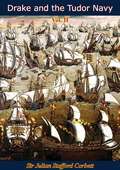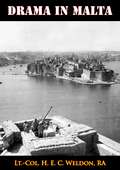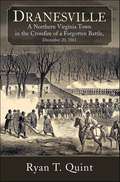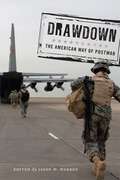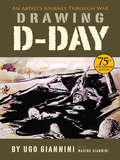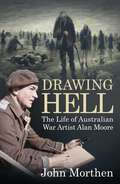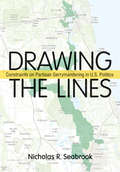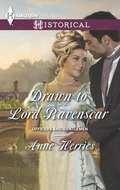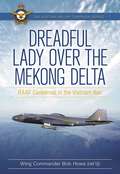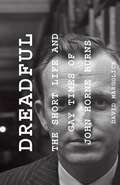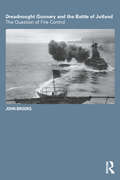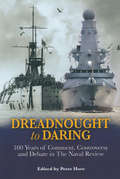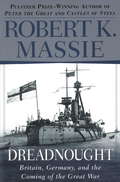- Table View
- List View
Dragon Rampant: The Royal Welch Fusiliers at War, 1793-1815
by Donald E. GravesI never saw any regiment in such order, said Wellington before the Battle of Waterloo, it was the most complete and handsome military body I ever looked at. The object of the Duke's admiration was the 23rd Regiment of Foot the famous Royal Welch Fusiliers and this is their story during the tumultuous and bloody period of the wars with France between 1793 and 1815. Based on rare personal memoirs and correspondence and new research, this compelling book offers fresh insight into the evolution of the British Army. Scorned by even its own countrymen in 1793, it was transformed within a generation into a professional force that triumphed over the greatest general and army of the time. The men of the Royal Welch Fusiliers come alive as Graves tracks them across three continents, joining them in major battles and minor skirmishes, surviving shipwrecks and disease. We come to know such fighting men as the intrepid Drummer Richard Bentinck, the eccentric Major Jack Hill, and their beloved commander, Lt-Col. Harvey Ellis, who led his Fusiliers in some of the most famous actions only to fall at the greatest of them all Waterloo. This is a book that will appeal to all those interested in the Napoleonic wars, contemporary tactics and the meaning and the cost of courage.
Dragon Rider: A Novel (The Soulbound Saga #1)
by Taran MatharuNew York Times bestselling author Taran Matharu’s debut adult fantasy series introduces an immersive story written in the tradition of the viral cultivation genre. Discover a rich world of magic, warriors, and dragons, in which a fearless orphan and an ambitious handmaiden flee from the empire that would imprison them, with a dream to return to their homelands and a determination that’s unbreakable… Can an orphan captive learn the secrets of the Dragon Riders to stand up and avenge his people?Jai lives as a royal hostage in the Sabine Court—ever since his father Rohan, leader of the Steppefolk, led a failed rebellion and was executed by the very emperor Jai now serves.When the emperor’s son and heir is betrothed to Princess Erica of the neighboring Dansk Kingdom, she brings with her a dowry: dragons. Endemic to the northern nation, these powerful beasts come in several forms, but mystery surrounds them. Only Dansk royalty know the secret to soulbonding with these dangerous beasts to draw on their power and strength. This marriage—and the alliance that forms—will change that forever.But conspirators lurk in the shadows, and soon the Sabine Court is in chaos. With his life in danger, Jai uses the opportunity to escape with the Dansk handmaiden, Frida, and a stolen hatchling. Hunted at every turn, he must learn to cultivate magic and become a soulbound warrior if he has any chance of finding safety, seizing his destiny…and seeking his revenge.
Dragon Season
by Michael CassuttAir Force lieutenant Rick Walsh has just gotten off a twelve-hour flight from Guam at the Tucson Airport. All he wants right now is too see his girlfriend Maia and maybe have a short rest before reassignment. What Lieutenant Walsh finds instead is a month-old infant and a mystery that spans two universes.Maia has disappeared, leaving behind her newborn, Gus, a baby with Walsh's eyes. It seems that a disturbing number of Tucson residents have gone missing as well and the authorities don't have a clue. As Walsh races to track down Maia and her possible kidnappers, a conspiracy unfolds as the search leads him deep into the desert and then on to someplace...else. What awaits Walsh in this other land proves sinister and dangerous--and it seems to have its eye on our world.In DRAGON SEASON, author Michael Cassutt weaves classic suspense and modern fantasy into a wild ride that readers won't soon forget.
Dragon Seed: A Novel of China at War (Colophon)
by Pearl S. BuckA New York Times–bestselling historical novel about the Japanese invasion of Nanking from the author of The Good Earth. Farmer Liang Tan knows only a quiet, traditional life in his remote Chinese farming community. When news filters in that Japanese forces are invading the country, he and his fellow villagers believe that if they behave decently to the Japanese soldiers, the civilians might remain undisturbed. They&’re in for a shock, as the attackers lay waste to the country and install a puppet government designed to systematically carry out Japanese interests. In response, the Chinese farmers and their families form a resistance—which not only carries grave risk, but also breaks their vow of nonviolence, leading them to wonder if they&’re any different than their enemy. Later adapted into a film featuring Katharine Hepburn, Dragon Seed is a brilliant and unflinching look at the horrors of war. This ebook features an illustrated biography of Pearl S. Buck including rare images from the author&’s estate.
Dragon's Jaw: An Epic Story of Courage and Tenacity in Vietnam
by Stephen Coonts Barrett TillmanA riveting Vietnam War story--and one of the most dramatic in aviation history--told by a New York Times bestselling author and a prominent aviation historianEvery war has its "bridge"--Old North Bridge at Concord, Burnside's Bridge at Antietam, the railway bridge over Burma's River Kwai, the bridge over Germany's Rhine River at Remagen, and the bridges over Korea's Toko Ri. In Vietnam it was the bridge at Thanh Hoa, called Dragon's Jaw.For seven long years hundreds of young US airmen flew sortie after sortie against North Vietnam's formidable and strategically important bridge, dodging a heavy concentration of anti-aircraft fire and enemy MiG planes. Many American airmen were shot down, killed, or captured and taken to the infamous "Hanoi Hilton" POW camp. But after each air attack, when the smoke cleared and the debris settled, the bridge stubbornly remained standing. For the North Vietnamese it became a symbol of their invincibility; for US war planners an obsession; for US airmen a testament to American mettle and valor.Using after-action reports, official records, and interviews with surviving pilots, as well as untapped Vietnamese sources, Dragon's Jaw chronicles American efforts to destroy the bridge, strike by bloody strike, putting readers into the cockpits, under fire. The story of the Dragon's Jaw is a story rich in bravery, courage, audacity, and sometimes luck, sometimes tragedy. The "bridge" story of Vietnam is an epic tale of war against a determined foe.
Dragonfly
by Leila MeachamFrom the New York Times bestselling author of Roses comes a gripping new novel about five young spies embedded among the highest Nazi ranks in occupied Paris At the height of World War II, a handful of idealistic young Americans receive a mysterious letter from the government, asking them if they are willing to fight for their country. The men and women from very different backgrounds-a Texan athlete with German roots, an upper-crust son of a French mother and a wealthy businessman, a dirt-poor Midwestern fly fisherman, an orphaned fashion designer, and a ravishingly beautiful female fencer-all answer the call of duty, but each for a secret reason of her or his own. They bond immediately, in a group code-named Dragonfly. Thus begins a dramatic cat-and-mouse game, as the group seeks to stay under the radar until a fatal misstep leads to the capture and the firing-squad execution of one of their team. But...is everything as it seems, or is this one more elaborate act of spycraft?
Dragonslayer: The Legend of Erich Ludendorff in the Weimar Republic and Third Reich (Battlegrounds: Cornell Studies in Military History)
by Jay LockenourIn this fascinating biography of the infamous ideologue Erich Ludendorff, Jay Lockenour complicates the classic depiction of this German World War I hero. Erich Ludendorff created for himself a persona that secured his place as one of the most prominent (and despicable) Germans of the twentieth century. With boundless energy and an obsession with detail, Ludendorff ascended to power and solidified a stable, public position among Germany's most influential. Between 1914 and his death in 1937, he was a war hero, a dictator, a right-wing activist, a failed putschist, a presidential candidate, a publisher, and a would-be prophet. He guided Germany's effort in the Great War between 1916 and 1918 and, importantly, set the tone for a politics of victimhood and revenge in the postwar era. Dragonslayer explores Ludendorff's life after 1918, arguing that the strange or unhinged personal traits most historians attribute to mental collapse were, in fact, integral to Ludendorff's political strategy. Lockenour asserts that Ludendorff patterned himself, sometimes consciously and sometimes unconsciously, on the dragonslayer of Germanic mythology, Siegfried—hero of the epic poem The Niebelungenlied and much admired by German nationalists. The symbolic power of this myth allowed Ludendorff to embody many Germans' fantasies of revenge after their defeat in 1918, keeping him relevant to political discourse despite his failure to hold high office or cultivate a mass following after World War I.Lockenour reveals the influence that Ludendorff's postwar career had on Germany's political culture and radical right during this tumultuous era. Dragonslayer is a tale as fabulist as fiction.
Dragonwars: Armed Struggle and the Conventions of Modern War
by J. Bowyer BellFor centuries international order has been troubled by small wars, insurrections, and revolts--low intensity conflicts. With the implosion of the Soviet empire many thought such violence could be eradicated through the growth of democracy, open societies, and increased productivity and education. Instead the world remains filled with turmoil, pogroms, famine, civil war, rebellion, and terror, often instigated by armed and dangerous zealots. To Americans such killers seem alien and inexplicable, fanatics without reason, beyond the reach of conventional containment or retaliation. J. Bowyer Bell here explores the psychological and strategic ecosystems (which he terms dragon worlds) of modern political violence and suggests how America might effectively deal with it.Dragonwars combines analysis with historical examples drawn from America's involvement with armed struggle in Lebanon, Central Am-erica, Greece, and Vietnam. In each instance, Bell argues, American policy was flawed by lack of empathy and historical understanding combined with a belief that failure could be traced to mistakes in details and procedures. The break up of the old bipolar U.S.-Soviet confrontation released suppressed ambitions, tribal greed, and greater flexibility for the small player. With new technologies of terror, zones of security will become smaller, since open societies present attractive targets for zealots. Bell rejects the notion that massive force can effect a swift and final result. Instead, a new type of warrior will be required; one versed in history and empathetic to the belief-systems of the dragonworlds in which they are deployed.Bell acknowledges that his proposals run counter to American belief and practice, but argues that in the face of insoluble conflicts, incremental advantages, through limited altered global arena, Dragonwars will prove an indispensable guide for policymakers, military planners, historians, and political scientists.
Dragoon Or Cavalryman, Major General John Buford In The American Civil War [Illustrated Edition]
by Major Mark R. StrickerIncludes more than 25 maps and illustrationsThis study investigates the American Civil War role and contributions of Major General John Buford. Buford, a 1848 graduate of the United States Military Academy, began his Army career on America's frontier with the First United States Dragoons. With the outbreak of the Civil War, Buford was selected to command a cavalry brigade in John Pope's Army of Virginia, and participated in the Second Manassas Campaign. Buford went on to make significant contributions to the Union efforts in the Eastern Theater; however, history has generally portrayed Buford as a one-dimensional character based on his stand along McPherson and Seminary Ridges on the first day of the Battle of Gettysburg. Several historians have presumed that the dismounted cavalry (or Dragoon) tactics used by Buford at Gettysburg were the culmination of a method of fighting which he helped develop and propagate within the Union cavalry. However, this thesis shows that contrary to this Dragoon image, Buford was in fact a remarkable cavalry officer. His battlefield tactics were fairly traditional, but it was not in pitched battles that Buford excelled. His significant contributions were in the established roles of cavalry; performing reconnaissance and providing security for the army he was supporting.
Drake and the Tudor Navy Vol. I (Drake and the Tudor Navy #1)
by Sir Julian Stafford CorbettTHE NAVAL ART IN THE MIDDLE OF THE SIXTEENTH CENTURYTHE conspicuous technical feature of the maritime revolution which in the sixteenth century transferred the focus of the naval art from the Mediterranean to the Atlantic is the transition from galley warfare to warfare under sail; and the history of that transition, of its causes, its development, and its results, is the history of the rise of the English naval supremacy.The whole of maritime warfare falls naturally into three periods, each sharply characterised by a generic difference in the ‘capital ship,’ as in the seventeenth century it was happily called—the ship, that is, which formed the backbone of a fighting fleet and which had a place in the fighting line. The first period is that of the galley, beginning in prehistoric times and culminating in the year 1571, at the battle of Lepanto; the second is that of the ‘great ship,’ or ‘ship of the line,’ which was established in 1588 with the campaign of the Great Armada, and reached its highest development at Trafalgar; the third is that in which we now live, the period of the ‘battleship.’ Or, to state the classification in terms of its real basis, there is a period of oars, a period of sails, and a period of steam.
Drake and the Tudor Navy Vol. II (Drake and the Tudor Navy #2)
by Sir Julian Stafford CorbettTHE NAVAL ART IN THE MIDDLE OF THE SIXTEENTH CENTURYTHE conspicuous technical feature of the maritime revolution which in the sixteenth century transferred the focus of the naval art from the Mediterranean to the Atlantic is the transition from galley warfare to warfare under sail; and the history of that transition, of its causes, its development, and its results, is the history of the rise of the English naval supremacy.The whole of maritime warfare falls naturally into three periods, each sharply characterised by a generic difference in the ‘capital ship,’ as in the seventeenth century it was happily called—the ship, that is, which formed the backbone of a fighting fleet and which had a place in the fighting line. The first period is that of the galley, beginning in prehistoric times and culminating in the year 1571, at the battle of Lepanto; the second is that of the ‘great ship,’ or ‘ship of the line,’ which was established in 1588 with the campaign of the Great Armada, and reached its highest development at Trafalgar; the third is that in which we now live, the period of the ‘battleship.’ Or, to state the classification in terms of its real basis, there is a period of oars, a period of sails, and a period of steam.
Drama In Malta
by Lt.-Col. H. E. C. Weldon R.A.A fascinating personal flashback, Weldon's account of his service as an artillery officer in Malta, 1939-1943, based on notes made during 1939-1943."A great deal of this personal narrative was originally jotted down in Malta during intervals between the raids. The remainder has been added, and the whole of it revised, while "On Active Service". There lie my excuses for any inconsistencies of style the reader may remark and also for the inclusion of certain episodes to the exclusion of others of at least equal importance. So much happened during the four years I lived out there and now, apart from an invaluable page of dry official statistics, I have only my memory to rely on as a guide. So I deemed it better to make the story a personal one and to tell mainly of those matters, whether military, social or dramatic, of which I had intimate knowledge and which would also serve to give a picture of the background to our lives and battles in that isolated little fortress."At the same time I have long felt that there should be wider knowledge of the part that was played by the Army in Malta and in particular by the Royal Regiment of Artillery and its brother in arms, the Royal Malta Artillery. It was by these men, without hope or relief or rest, that the constant strain of three years of bombing, isolation and blockade was borne. The epics of naval heroism that ensured the provisioning of Malta and the doughty deeds of the Royal Air Force in its defence are justly renowned through the press and official publications alike. This pen of mine is a very inadequate instrument with which to describe the contribution of the Army as a whole at its true worth. The back-breaking jobs, the constant vigils and spirited defence of those magnificent battalions of Infantry need a scribe of their own. Suffice it for me to say that the names of Hal Far and the Devons, Luqa and the West Kents, Ta Kali and the Manchesters, Safi and the Hampshires, the Dockyard and the Cheshires, to mention only some, will forever be indissolubly linked in glory and friendship."But over half of the garrison were "gunners"--English and Maltese--and it is because I am immensely proud of having had the privilege both of serving in Malta during those stirring times and of being a humble member of the Royal Regiment of Artillery that these pages are written in honour of:"The Gunners in Malta, 1940--1943."
Dramaturgies of War: Institutional Dramaturgy, Politics, and Conflict in 20th-Century Germany
by Anselm Heinrich Ann-Christine SimkeThis book examines the institutional contexts of dramaturgical practices in the changing political landscape of 20th century Germany. Through wide-ranging case studies, it discusses the way in which operationalised modes of action, legal frameworks and an established profession have shaped dramaturgical practice and thus links to current debates around the “institutional turn” in theatre and performance studies. German theatre represents a rich and well-chosen field as it is here where the role of the dramaturg was first created and where dramaturgy played a significantly politicised role in the changing political systems of the 20th century. The volume represents an important addition to a growing field of work on dramaturgy by contributing to a historical contextualisation of current practice. In doing so, it understands dramaturgy not only as a process which occurs in rehearsal rooms and writers’ studies, but one that has far wider institutional and political implications.
Dranesville: A Northern Virginia Town in the Crossfire of a Forgotten Battle, December 20, 1861
by Ryan T. QuintHere for the first time, shared through the eyes of those who lived it, is the story of Dranesville and the early war in Northern Virginia. After the guns of Manassas fell silent, the opposing armies grappled for position wondering what would come next. Popular history has us believe it was “All quiet along the Potomac.” Reality was altogether different. The fall and early winter of 1861 was a hotbed of activity that culminated in the December combat at Dranesville. The Union victory, although small when measured against what was to come, was sorely needed after the string of defeats at Bull Run, Wilson’s Creek, and Ball’s Bluff; it also helped shape many of the players in the bloody years to come. Ryan Quint’s Dranesville: A Northern Virginia Town in the Crossfire of a Forgotten Battle, December 20, 1861, is the first full history of that narrow but critically important slice of the war. No one knew what was coming, but soon civilians (sympathetic to both sides) were thrown into a spreading civil war of their own as neighbor turned on neighbor. In time, this style of warfare, on the home front and on the battlefield, reached the town of Dranesville in Fairfax County. This mostly forgotten story uses overlooked or underused sources to sweep readers along from the White House and Charleston’s Secession Hall to midnight ambushes and the climactic Dranesville action. A host of characters and commanders that would become household names cut their teeth during these months, including Generals J. E. B. Stuart and Edward Ord. The men of the Pennsylvania Reserves saw their baptism of fire at Dranesville, setting the Keystone State soldiers on a path to becoming one of the best combat units of the entire war. Though eclipsed by larger and bloodier battles, Dranesville remained a defining moment for many of its participants—soldiers and civilians alike—for the rest of their lives. Here for the first time, shared through the eyes of those who lived it, is the story of Dranesville and the early war in Northern Virginia.
Drawdown: The American Way of Postwar (Warfare and Culture #8)
by Jason W. WarrenAnalyzes the cultural attitudes, political decisions, and institutions surrounding the maintenance of armed forces throughout American history While traditionally, Americans view expensive military structure as a poor investment and a threat to liberty, they also require a guarantee of that very freedom, necessitating the employment of armed forces. Beginning with the seventeenth-century wars of the English colonies, Americans typically increased their military capabilities at the beginning of conflicts only to decrease them at the apparent conclusion of hostilities. In Drawdown: The American Way of Postwar, a stellar team of military historians argue that the United States sometimes managed effective drawdowns, sowing the seeds of future victory that Americans eventually reaped. Yet at other times, the drawing down of military capabilities undermined our readiness and flexibility, leading to more costly wars and perhaps defeat. The political choice to reduce military capabilities is influenced by Anglo-American pecuniary decisions and traditional fears of government oppression, and it has been haphazard at best throughout American history. These two factors form the basic American “liberty dilemma,” the vexed relationship between the nation and its military apparatuses from the founding of the first colonies through to present times. With the termination of large-scale operations in Iraq and the winnowing of forces in Afghanistan, the United States military once again faces a significant drawdown in standing force structure and capabilities. The political and military debate currently raging around how best to affect this force reduction continues to lack a proper historical perspective. This volume aspires to inform this dialogue. Not a traditional military history, Drawdown analyzes cultural attitudes, political decisions, and institutions surrounding the maintenance of armed forces.
Drawing D-Day: An Artist's Journey Through War
by Ugo Giannini Maxine Giannini“Drawing D-Day powerfully and poignantly reflects back on the watershed event of the 20th century in a way that is unexpected and completely unique.” — Jeffery R. Fulgham, CFRE, Vice President, Finance and Development, National D-Day Memorial FoundationDrawing D-Day: An Artist's Journey Through War offers an extraordinary, one-of-a-kind testimony in words and images by a soldier and artist who participated in one of the most famous military operations of World War II. On June 6, 1944, Ugo Giannini landed on Omaha Beach with a platoon of military police assigned to accompany the U.S. Army's 29th Infantry Division. Only six of the thirty-seven men in the platoon made it to the beach. Told that he was needed on the bluff above the shore, Ugo climbed the Verville Draw, jumped into a crater made by naval bombardment, and spent that day and part of the next as an eyewitness to the invasion. Remarkably, he began to draw. These are the only known drawings from that historic day. Drawn in pencil and pen, in a gritty, realist style, the images depict heavily burdened infantrymen trying to stay afloat in seawater, crawling on the beach, and dead among the ruins of a bombed-out village. The illustrations, interwoven with Ugo's letters to his family and girlfriend, portray the horror of war in a deep and personal way. Abstract paintings at the end of the book, composed forty years later, make a powerful statement of the enduring power about war on an artist-soldier's psyche.
Drawing Hell: The Life of War Artist - Alan Moore
by J P Morthen"From the sweltering battlefields of the South Pacific to the devastated cities of Europe, Alan Moore witnessed the greatest war in human history—not with a rifle, but with a paintbrush."As an official war artist with the RAAF, Moore was sent deep into the action, capturing history as it unfolded. He documented the brutal Japanese counterattack at Los Negros Island, the perilous missions of airmen dodging flak over Eastern Europe, and the harrowing reality inside one of Nazi Germany&’s most infamous concentration camps. With his camera, sketchbook, and oil paints, he recorded not just battles, but the human cost of war—the exhaustion, the fear, the destruction, and the small moments of resilience that defined a generation. Yet despite his remarkable body of work, Alan Moore remains one of Australia&’s forgotten artists. His paintings, raw and unfiltered, serve as powerful reminders of the horrors of war, ensuring that the sacrifices of those who served are never lost to history. Through meticulous research and rare archival materials, Drawing Hell unearths the story of a man whose work still hangs in some of the world&’s most prestigious museums and galleries. Moore&’s life spanned a century of conflict, change, and artistic evolution, yet his story has remained largely untold—until now. In this gripping account, historian John Morthen brings Moore&’s legacy back into the spotlight, revealing how his art shaped the way we remember war. For those who believe history should never be forgotten, Drawing Hell is an essential read.
Drawing the Lines: Constraints on Partisan Gerrymandering in U.S. Politics
by Nicholas R. SeabrookRadical redistricting plans, such as that pushed through by Texas governor Rick Perry in 2003, are frequently used for partisan purposes. Perry's plan sent twenty-one Republicans (and only eleven Democrats) to Congress in the 2004 elections. Such heavy-handed tactics strike many as contrary to basic democratic principles. In Drawing the Lines, Nicholas R. Seabrook uses a combination of political science methods and legal studies insights to investigate the effects of redistricting on U.S. House elections. He concludes that partisan gerrymandering poses far less of a threat to democratic accountability than conventional wisdom would suggest.Building on a large data set of the demographics of redrawn districts and subsequent congressional elections, Seabrook looks less at the who and how of gerrymandering and considers more closely the practical effects of partisan redistricting plans. He finds that the redrawing of districts often results in no detrimental effect for district-level competition. Short-term benefits in terms of capturing seats are sometimes achieved but long-term results are uncertain. By focusing on the end results rather than on the motivations of political actors, Seabrook seeks to recast the political debate about the importance of partisanship. He supports institutionalizing metrics for competitiveness that would prove more threatening to all incumbents no matter their party affiliation.
Drawn to Lord Ravenscar
by Anne HerriesBETRAYED BY MARRIAGE When her betrothed is brutally murdered Lucy Dawlish looks for comfort from the man who shares her grief-his brother, Paul Ravenscar. Virtuous Lucy has always been secretly drawn to this frosty lord, but is it too late to reveal where her heart truly lies? Paul Ravenscar must marry and produce an heir for the sake of his estate, but there is only one woman he wants. To claim Lucy as his bride risks betraying his brother's memory, but Paul might be unable to keep his feelings hidden.... Officers and Gentlemen For duty, for honor, for love
Dreadful Lady over the Mekong Delta: RAAF Canberras in the Vietnam War
by Bob HoweDreadful Lady over the Mekong Delta looks at the men of No 2 Squadron and the operations they flew in the Vietnam War in their Canberra bombers. From April 1967, the squadron spent four years attacking enemy targets, many of them in the Mekong Delta region, and contending with the politics, weather, and &‘fog&’ of war. The riverine operations supported by No 2 Squadron were but a small part of an allied effort to disrupt the enemy&’s movement of troops and supplies to locations in South Vietnam. It was, according to one commentator, &‘a kind of guerrilla warfare conducted in a navy environment&’. Bob Howe arrived in Vietnam in 1969 as a youthful Canberra navigator/bomb-aimer, but much of his time was spent as a specialist in bombing operations. His time there provided him with the firsthand experience and detailed information to write this book. This book in its original format was first published in 2016 by the RAAF&’s Air Power Development Centre, filling a gap in the recording of the RAAF&’s operations in Vietnam. It also describes how crews overcame the difficulties of operating in an intense Asian war in an aircraft that was designed for a completely different environment. This new edition is intended to bring the experiences and exploits of Bob Howe, No 2 Squadron and its Canberra bomber aircraft to life for a new generation of reader.
Dreadful: The Short Life and Gay Times of John Horne Burns
by David MargolickAmerican author John Horne Burns (1916-1953) led a brief and controversial life, and as a writer, transformed many of his darkest experiences into literature. Burns was born in Massachusetts, graduated from Andover and Harvard, and went on to teach English at the Loomis School, a boarding school for boys in Windsor, Connecticut. During World War II, he was stationed in Africa and Italy, and worked mainly in military intelligence. His first novel, The Gallery (1947), based on his wartime experiences, is a critically acclaimed novel and one of the first to unflinchingly depict gay life in the military. The Gallery sold half a million copies upon publication, but never again would Burns receive that kind of critical or popular attention. Dreadful follows Burns, from his education at the best schools to his final years of drinking and depression in Italy. With intelligence and insight, David Margolick examines Burns's moral ambivalence toward the behavior of American soldiers stationed with him in Naples, and the scandal surrounding his second novel, Lucifer with a Book, an unflattering portrayal of his experiences at Loomis.
Dreadnought Gunnery and the Battle of Jutland: The Question of Fire Control
by John BrooksThis new book reviews critically recent studies of fire control, and describes the essentials of naval gunnery in the dreadnought era.With a foreword by Professor Andrew Lambert, it shows how, in 1913, the Admiralty rejected Arthur Pollen's Argo system for the Dreyer fire control tables. Many naval historians now believe that, consequently, Br
Dreadnought to Daring: 100 Years of Comment, Controversy and Debate in The Naval Review
by Peter HoreDreadnought to Daring is an absorbing and highly readable summary of a century of naval thinking which has been written by some of the leading lights in contemporary naval history.Founded in 1912 by some of the Royal Navys brightest officers, the quarterly Naval Review has never been subject to official censorship, and its naval members do not need official permission to write for it, so it has always provided an independent, lively and at times outspoken forum for service debate. In broad terms it has covered contemporary operations, principles of naval warfare, history, and anecdotes which record the lighter side of naval life, but sometimes with a bite to them. A correspondence section provides an important barometer of service opinion, while extensive book reviews, written by those with real knowledge of the subject, carry considerable weight. For these reasons the Naval Review is widely regarded as a journal of record.In return for its freedom, circulation is restricted to members and membership to serving or retired officers. However, this volume will give the interested public an insight into its activities, past and present. Intended both to celebrate and to analyse the impact of the journal over its 100-year history, it comprises a series of specially commissioned articles, divided chronologically and thematically, devoted to subjects that have been of importance to the naval community as reflected in the pages of the journal. It concludes with an assessment of how well the Naval Review has succeeded in its founders aim and what influence it has had on policy.
Dreadnought: Britain, Germany, and the Coming of the Great War
by Robert K. Massie"A classic [that] covers superbly a whole era...Engrossing in its glittering gallery of characters."CHICAGO SUN-TIMES. Pulitzer Prize-winning author, Robert K. Massie has written a richly textured and gripping chronicle of the personal and national rivalries that led to the twentieth century's first great arms race. Massie brings to vivid life, such historical figures as the single-minded Admiral von Tirpitz, the young, ambitious, Winston Churchill, the ruthless, sycophantic Chancellor Bernhard von Bulow, and many others. Their story, and the story of the era, filled with misunderstandings, missed opportunities, and events leading to unintended conclusions, unfolds like a Greek tragedy in his powerful narrative. Intimately human and dramatic, DREADNOUGHT is history at its most riveting.
Dreadnoughts and Super-Dreadnoughts (Casemate Illustrated Special)
by Chris McNabA heavily illustrated account of the evolution, design and deployment of dreadnought battleships.When HMS Dreadnought was commissioned into the Royal Navy in 1906 this revolutionary new class of big-gun iron-clad warship immediately changed the face of naval warfare, rendering all other battleships worldwide obsolete. The Admiralty realised that as soon as the ship was revealed to the global naval community Britain would be a in race to stay ahead, and so the first dreadnoughts were built in record time. While there were those who regarded the vessel as a triumphant revolution in naval design, the dreadnought initially had its critics, including those who thought its slower, heavier guns left it vulnerable to the secondary armament of other warships. Nevertheless, other countries, notably Germany, and the United States soon began to lay down dreadnoughts. The culmination of this arms race would be the confrontation of the British and German fleets at the Battle of Jutland in May 1916 – the greatest clash of naval firepower in history. This book gives detailed insights into the design, operation and combat history of these incredible vessels.

